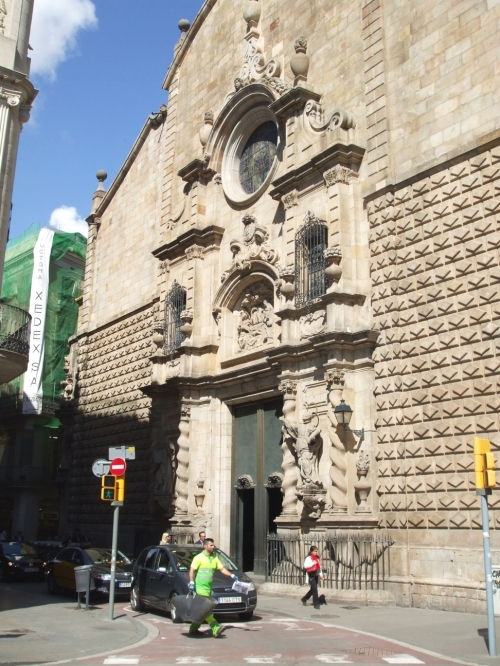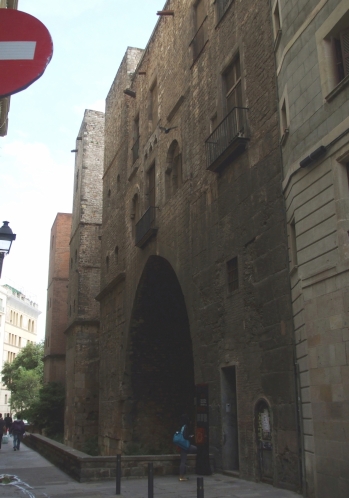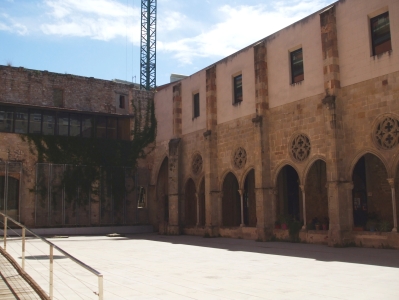The camera never lies, as well we know, and in this particular instance it seems to know better than me as despite my account of two posts ago it seems rather as if I went from the Biblioteca de Catalunya to the Archivo de la Corona de Aragón and not the other way round. Nonetheless, there is a lot to see whichever way you do it and a surprising amount of medieval scenery either in plain view or just tucked away round a corner…
On your right, ladies and gentlemen, the old Hopital de la Santa Creu, now home to the Biblioteca de Catalunya. On your left, a street away, the red light district, and in the middle of it, defensively locked until one knocks, the bookshop of the Institut d’Estudis Catalans. I thus wind up visiting the locality every time I’m in Barcelona and coming away with two or three volumes of the Catalunya Carolíngia, which is probably a more lasting use of Euros than most of its visitors manage…

At the end of the Carrer del Carme, the seventeenth-century Iglesia de Betlem, here seen from the Rambla, not medieval but still pretty splendid
This church has become my anchor point. When I reach this far along the Ramblas, I can be sure I didn’t turn the wrong way coming out of the metro station. Thus it features in the journey report despite its baroque date.

Before wandering very far, the erstwhile nunnery of Sant Pere de les Puelles
The original Sant Pere de les Puelles was the second or perhaps the third known nunnery of Catalonia, founded by none other than Count-Marquis Borrell II of Barcelona. It was then outside the city, it should be said. It’s not entirely clear who the first abbess was but either she or the second was one Filmera, daughter of Borrell’s mighty vassal Sal·la of Bages and thus brothersister (oops) to Unifred Amat of whom we have heard so much here. She outlived him, but her ultimate fate is unpleasant as she was captured by Muslim forces along with all her nuns during the 985 sack of Barcelona. For Borrell, however, this was only a mitigated disaster, as the next abbess was his daughter, Adelaide Bonafilla. It may have been Adelaide under whom the lower part of this building was put up, it is apparently eleventh-century though how one justifies that conclusion I do not know and I think it must be pretty late-eleventh if so. It was, anyway, retoppped in Gothic style in the fourteenth century, by which stage I guess that the city had come out to meet it a bit more. I’ve been through here before and didn’t realise it was this Sant Pere, but what I can tell you is it’s hard to photograph without messing up a street football game.
Just down the road, on the Carrer de les Basses de Sant Pere, there is a pottery merchant’s working out of what seems pretty inarguably to be a Romanesque town house. There’s no signage or anything; it’s just a house, and it has presumably been so for quite a long time.
Then down the Carrer de la Sèquia to where it forks, left onto the Carrer Sant Agustí Vell and suddenly a vestige of that same edifice, though not at all signposted as such, appears to the left just demanding to be investigated.
I did not, on this occasion, have time to stop for a coffee here, here being the Bar del Convent apparently, but some day I will have plural days in Barcelona and then it’s getting done. I feel as if they might have reason to overcharge in the way that most Barcelona places do despite not being covered in Gothic vaulting. There seems to be a lot going on here and endeavours worth supporting, too. It’s a good space and even if monastic quiet is not what you’re now getting here, I’m glad it has uses.
Then finally three pictures I can’t work out my route for. Presumably I wasn’t just zig-zagging accidentally over the city, but no attempt I can make with Google Maps makes a sensible route out of these.

I am still apparently trying to get decent photos of the bits of the Roman walls that are still visible in the street here…

And which church is this? I fear I have no ideaThankfully competent local knowledge in comments can assure me that this is the Esglésie de Sant Jaume. Thankyou Joan!
There’s always more to find, though. A substantial fraction of this city seems to be reused medieval fabric, and every now and then you’ll turn your head and just about catch it…










I would say that this is your unnamed chuch.
I agree! Thankyou, I’ll amend. But that doesn’t make my itinerary any clearer. I think that I must have had these files wrongly sorted when I put numbers on them…
Either that or you were caught by the spell of the city… Traveling and dreamming have many things in common, unexplained pictures or memories somehow just make-it better… :)
It should always be remembered that the Gothic Quarter in Barcelona is a medieval theme-park created in the 20th century. This recreation is a fortuitous example of an invention of tradition meant to compete with Florence and other spectacular Italian tourist magnets (it has earned Barcelona the status of being the 6th most visited city in Europe and a huge income). But it is a reconstruction: between 1887 and 1912 the facade of the Cathedral was finally finished in a neo-gothic style. This gave the impetus to nationalist Catalan politicians to reinvent the whole quarter. More than 40 buildings were either recreated (fitted with typical “gothic” windows) or simply moved from one location to another.) At the same time the local “industrial population” aka “the working class” was moved to the outskirts in the same way as we today “remove” the homeless from the inner cities. Thus old Barcelona was changed from a residential area into a space ready for tourist consumption while the new neo-medieval buildings were put to use as either museums or government offices. Central to these reconstructions were the ideas by de Puig i Cadafalch epitomized by the architect Jeroni Martorell, who construed the ideal edifice: “The Catalan House”, situated behind the Cathedral – Casa de los Canónigos at Bisbe Irurita Street. This is the one with the famous “Gothic Bridge” which even the re-inventors felt was “too much” of an “invention” (nevertheless it figures in nearly every guide in town). There is just only more sight in Barcelona which is more tacky: Poble Espanyol de Montjuic. (But that is quite another story).
Jonathan, I should like to take coffee with you at Bar del Convent – but at least we both know now why it will be so forbiddingly expensive!
The story is being told by Joan Ganau in a large number of publications: here are two links:
http://www.tandfonline.com/doi/abs/10.1080/1743873X.2013.815760?journalCode=rjht20#.U-CZzlZG00A (The Invention of the Barcelona Gothic Quarter)
http://www.geosoc.udl.es/professorat/ganau/gotic.pdf (Invention and Authenticity in Barcelona’s Barri Góthic
Another article well-worth reading is by Agustín Cócola Gant:
http://www.ub.edu/geocrit/sn/sn-371.htm (El Barrio Gótico). It tells the story behind the politics of the reinvention
How fascinating! I was only on the edge of the Barri Gòtic for much of this post, I think, but it’s comforting to think that the hidden buildings might be the more authentic.
I would recommend the assistance next 19-20-nov-2014 to : Jornades “Destinació BCN. Història del turisme a la ciutat”.
Dear Jonathan. Yes! In the end everything is spoliae. Like the antique marble columns imported to Roskilde Cathedral around 1070; one of which was later “pinched” by the Archbishop Peder Jensen Lodehat, when he built his medieval palace, Gjorslev – http://en.wikipedia.org/wiki/Gjorslev – in 1396. And so forth and so on… And to Joan: Thank you for the link. It looks very interesting.
I have one insightful comment to add here, and that is: i would like to drink at that bar.
Who knows but what this may be possible?
Coming to this much later… isn’t there a Museu de Xocolat somewhere near Sant Agustí Vell? Clearly an authentic use of space!
There is! I’ve never been in it, but it’s certainly there. Some day when I have time and money enough in Barcelona at once…
I’ve visited. An interesting way to spend part of an afternoon, but not quite worth the price of admission, in my opinion. Of course, I’m generally reluctant to part with dollars, euros, pounds, or really any currency, so I might not be the best source.